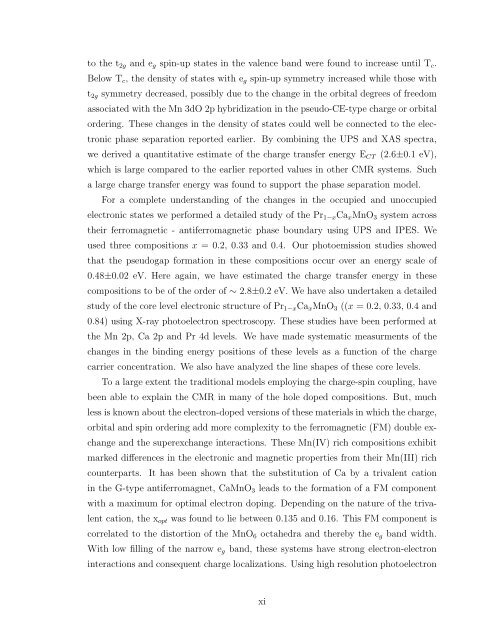PHYS07200604007 Manas Kumar Dala - Homi Bhabha National ...
PHYS07200604007 Manas Kumar Dala - Homi Bhabha National ...
PHYS07200604007 Manas Kumar Dala - Homi Bhabha National ...
Create successful ePaper yourself
Turn your PDF publications into a flip-book with our unique Google optimized e-Paper software.
to the t 2g and e g spin-up states in the valence band were found to increase until T c .<br />
Below T c , the density of states with e g spin-up symmetry increased while those with<br />
t 2g symmetry decreased, possibly due to the change in the orbital degrees of freedom<br />
associated with the Mn 3dO 2p hybridization in the pseudo-CE-type charge or orbital<br />
ordering. These changes in the density of states could well be connected to the electronic<br />
phase separation reported earlier. By combining the UPS and XAS spectra,<br />
we derived a quantitative estimate of the charge transfer energy E CT (2.6±0.1 eV),<br />
which is large compared to the earlier reported values in other CMR systems. Such<br />
a large charge transfer energy was found to support the phase separation model.<br />
For a complete understanding of the changes in the occupied and unoccupied<br />
electronic states we performed a detailed study of the Pr 1−x Ca x MnO 3 system across<br />
their ferromagnetic - antiferromagnetic phase boundary using UPS and IPES. We<br />
used three compositions x = 0.2, 0.33 and 0.4. Our photoemission studies showed<br />
that the pseudogap formation in these compositions occur over an energy scale of<br />
0.48±0.02 eV. Here again, we have estimated the charge transfer energy in these<br />
compositions to be of the order of ∼ 2.8±0.2 eV. We have also undertaken a detailed<br />
study of the core level electronic structure of Pr 1−x Ca x MnO 3 ((x = 0.2, 0.33, 0.4 and<br />
0.84) using X-ray photoelectron spectroscopy. These studies have been performed at<br />
the Mn 2p, Ca 2p and Pr 4d levels. We have made systematic measurments of the<br />
changes in the binding energy positions of these levels as a function of the charge<br />
carrier concentration. We also have analyzed the line shapes of these core levels.<br />
To a large extent the traditional models employing the charge-spin coupling, have<br />
been able to explain the CMR in many of the hole doped compositions. But, much<br />
less is known about the electron-doped versions of these materials in which the charge,<br />
orbital and spin ordering add more complexity to the ferromagnetic (FM) double exchange<br />
and the superexchange interactions. These Mn(IV) rich compositions exhibit<br />
marked differences in the electronic and magnetic properties from their Mn(III) rich<br />
counterparts. It has been shown that the substitution of Ca by a trivalent cation<br />
in the G-type antiferromagnet, CaMnO 3 leads to the formation of a FM component<br />
with a maximum for optimal electron doping. Depending on the nature of the trivalent<br />
cation, the x opt was found to lie between 0.135 and 0.16. This FM component is<br />
correlated to the distortion of the MnO 6 octahedra and thereby the e g band width.<br />
With low filling of the narrow e g band, these systems have strong electron-electron<br />
interactions and consequent charge localizations. Using high resolution photoelectron<br />
xi
















